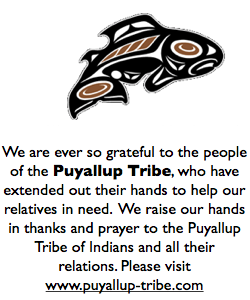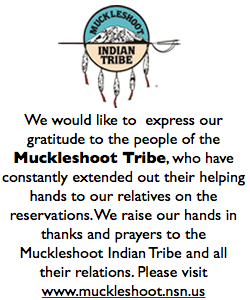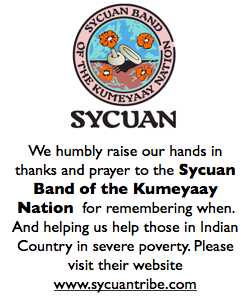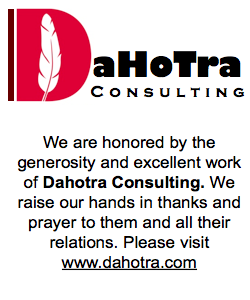Question: DO ALL TRIBES HAVE CASINOS?
Answer: NO THEY DO NOT!
“Contrary to popular belief, NOT ALL TRIBES HAVE CASINOS. In fact, out of the 562 federally recognized tribes only about 220 have Casinos/Gaming on their tribal land.” 87% of all gaming revenue generated goes to only 13% of all tribes”.
(United States Senate on Indian Affairs Committee)
_____________________________________________
Fact is unfortunately most of these Casino’s / gaming facility’s are not owned by the tribes whose lands they are built on. Most of these tribes have very little, some have nothing at all. Most of the children and their family’s who live on these lands are living in or below third world conditions. There are many women and children who go to bed without basic human needs, right here in the United States.
_____________________________________________
NATIONAL GAMBLING IMPACT STUDY COMMISSION
Proponents and critics alike acknowledge that Foxwoods casino is unique in the world of Indian gaming. Foxwoods’ success is the result of a deal struck with the state of Connecticut in 1991 (the casino opened in February 1992). In the deal, the state was granted 1/4 of the gross revenues from slot machines in exchange for legalizing slot machines exclusively for Foxwoods and the nearby Mohegan reservation, in addition to other provisions such as the surrender of old land claims making their way through the unpredictable federal courts.
_____________________________________________
THE FACTS ARE,
“There are currently 4.1 million American Indians residing in the United States, most of whom live on reservations. The disparities confronting these peoples are the most extreme of any ethnic group in the United States. Not only do American Indians have the highest rates of poverty (over twice that of all other ethnic groups), but they also have the highest unemployment and worst rates of disease. If this is surprising, also consider the following”
(Senate Indian Affairs Committee)
_____________________________________________
“The poverty rate increases to 31.2% when addressing American Indians living on reservations; that is 1 in 3 people”
(United States Census Bureau,).
_____________________________________________
“Approximately 90,000 Native families are homeless or under-housed”.
(United States Senate Indian Affairs Committee,)
_____________________________________________
“30% of homes on reservations are overcrowded, compared to 5.7% of homes of the general U.S. population”.
(Senate Indian Affairs Committee,)
_____________________________________________
“American Indians are 670 percent more likely to die from alcoholism, 650 percent more likely to die from tuberculosis, 318 percent more likely to die from diabetes than any other ethnic group”
(Indian Health Services,)
_____________________________________________
“American Indian schools will spend approximately $3,000 per student, less than half the amount that other public schools will spend”
(Bureau of Indian Affairs,)
_____________________________________________
“Over 50% of homes on reservations lack connection to a public sewage system, compared to 1.2% of the general U.S. population”.
(United States Senate Indian Affairs Committee,)
Median age of the single-race American Indian and Alaska Native population in 2008, younger than the median of 36.8 for the population as a whole. About 30 percent of American Indians and Alaska Natives were younger than 18, and 8 percent were 65 and older.
Read more: American Indians: Census Facts | Infoplease.com http://www.infoplease.com/spot/aihmcensus1.html#ixzz2apNYdaDz
About 22% of our country’s 5.2 million Native Americans live on tribal lands (2010 U.S. Census). Living conditions on the reservations have been cited as “comparable to Third World,”
Typically, Tribal and Federal governments are the largest employers on the reservations.
Many households are overcrowded and earn only social security, disability or veteran’s income.
The scarcity of jobs and lack of economic opportunity mean that, depending on the reservation, four to eight out of ten adults on reservations are unemployed.
Among American Indians who are employed, many are earning below poverty wages
(2005 BIA American Indian Population & Labor Force Report).
The overall percentage of American Indians living below the federal poverty line is 28.2% (2008, American Indians Census Facts).
The disparity for American Indians living below poverty on the reservations is even greater, reaching 38% to 63% in our service area
(National Center for Education Statistics, and other sources).
“The average life expectancy for Native Americans has improved yet still trails that of other Americans by almost 5 years”
(2010, HHS Indian Health Disparities Fact Sheet)
About 55% of American Indians rely on the Indian Health Service for medical care
(Indian Health Facts).
Yet, the Indian Health Care Improvement Act only meets about 60% of their health needs
(U.S. Commission on Civil Rights)
Due to underfunding, Indian Health Service facilities are crisis-driven and leave a wide gap in adequate and preventative health care for many Native Americans on the reservations. Pharmacies and doctor’s offices outside of hospitals are completely non-existent in some communities.
http://www.nrcprograms.org/site/PageServer?pagename=naa_livingconditions
TEN LARGEST RESERVATIONS IN SEVERE POVERTY
Navajo:
Nearly half of the families on the reservation (47%) live in poverty with 15% in extreme poverty
Uintah and Ouray:
More than half of the families on the reservation (54%) live in poverty with 4% in extreme poverty.
Tohono O’odham:
The poverty rate is about 44% with 21% of all households living in extreme poverty
Cheyenne River:
Two out of five of the reservation households (42%) live in poverty and 15% are in extreme poverty.
Standing Rock:
Of the families living on the reservation, 41% live in poverty with 17% living in extreme poverty.
Crow:
About one-third of the families on the reservation (32%) live in poverty with 10% living in extreme poverty.
Wind River:
The poverty rate on the Wind River Reservation is low compared to many other reservations: 23% live in poverty with 13% in extreme poverty.
Pine Ridge:
More than half of the families on the reservation (53%) live in poverty with 21% living in extreme poverty.
Fort Peck:
About 39% of the Fort Peck residents live in poverty with 10% living in extreme poverty.
San Carlos Apache:
More than half of the families on the reservation (53%) live in poverty, with 25% living in extreme poverty.
More Info:
www.dailykos.com/story/2012/12/06/1167663/-Indians-101-Reservation-Poverty




